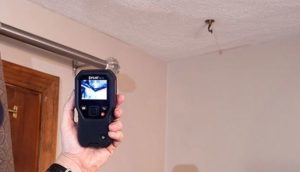Part one: Knowing where to look and what to look for is step one toward the goal of breathing easier in a clean & healthy kitchen. Common sources of mold like forgotten leftovers or a leak under the sink are easy to spot. In this three part series, MFM will dive into locating & eradicating toxin sources in your kitchen as part of your Mold Free diet and lifestyle.

Mold spores are often elevated in the kitchen for many reasons – there are water & humidity sources, places where food particles slip out of sight, and an assortment of spots that collect dust to name a few. Knowing how to remove the resulting microscopic particles and where to clean is an important first step toward healing for those suffering from CIRS, Lyme disease and other autoimmune conditions.
We spend a lot of time in the kitchen- preparing food, washing dishes, eating, talking. It’s where we store our groceries and our leftovers linger. Perhaps you’ve noticed the kitchen sponge is stinky, or an odor when you open the refrigerator? Maybe you have houseplants on the kitchen windowsill… read on to learn more about surprising places mold can linger. It’s time to figure out where toxic mold, bacteria, and fungus are hiding and take steps to create better indoor air quality.
23 places mold and bacteria can lurk in your kitchen
The list below is a great checklist to begin exploring. If you see debris or pick up any odor – it needs to be cleaned or replaced. Mold and bacteria grow fast in kitchen environments, so act quickly.
sponges and cleaning rags, dish towels
pet bowls, tanks
In and around the dishwasher
blender
microwave
In and around the garbage disposal
rubber spatulas & food storage lids
under the floor mat
ice and water dispensers
cabinets and food storage area
refrigerator crisper
recycling/garbage bin areas
vents
windowsills
behind and atop appliances
refrigerator drip pans
backsplash
coffee maker
underneath the sink
behind walls and built in cabinets
cookbooks, magazines, and baskets
spice racks
Contrary to common belief- toxic mold is not always visible. Black mold (Stachybotrys chartarum) for example is highly toxic and easily visible as black spots and patches on surfaces like walls. For anyone suffering from CIRS, mold sensitivity is heightened and symptoms can occur even if the ‘mold is invisible’. Did you know that ‘Large mold infestations can usually be seen or smelled” (https://www.cdc.gov/mold/faqs.htm) but mold/fungus/mildew can have toxic counts even in the beginning stage of growth when they are invisible to the naked eye? Consider the damp sponge at the kitchen sink. If your nose picks up an odor, mold and bacteria are multiplying rapidly even though the sponge might look clean. This example could be one of many small sources of mold in your kitchen. The unfortunate takeaway is that multiple small sources can add up to become a health hazard. The better news is most of the small sources can be easily cleaned or eliminated altogether.
Smaller sources of mold/ fungus/mildew you or your housecleaner can easily locate include: sponges & towels, pet bowls & mats, the blender jar, microwave, rubber spatulas & food storage lids, under the floor mat, ice and water dispensers, cabinets & food storage areas, refrigerator crisper, recycling/garbage bin areas, hood vents, windowsills, behind and atop appliances, refrigerator drip pans, backsplash, shelves with houseplants, the coffee maker, cookbooks, magazines, and baskets, and spice racks.
Inspection for the smaller items listed above is easy and affordable. Look for any discoloration, debris & dust of any kind, spots (fuzzy or not), surface damage like cracks/bubbles/stains. Also use your nose – if something has an odor, however faint, it is not clean and could be harboring small amounts of unhealthy bacteria. If you are not sure if you’re picking up a smell, ask another person to help. It may seem a bit awkward at first to be ‘smelling’ everything in your kitchen, but it is very effective. Note: if you or your helper is at all sensitive to mold or recovering from CIRS, Lyme disease, or autoimmune, please delegate this sniffing test to someone else. If you can smell it, there are invisible spores being inhaled and not worth exacerbating an already inflammatory condition.
If you prefer to delegate the locating of small mold sources to your house cleaning team- ask them to perform a thorough visual and olfaction exploration of your kitchen for you. It will likely be an additional fee for the time spent doing so, and should be performed on a regular basis to keep the small sources of kitchen mold from escalating into something large and unhealthy.
If any item shows signs of contamination by appearance or scent- NOW is the time to clean or replace the item. See the MFM post part two for more on proper cleaning & replacing of contaminated items.
Larger sources of mold in your kitchen might take a bit more investigation to locate.
The wall behind your kitchen sink is not usually something you look at daily, like a kitchen sponge- but a tiny leak at a pipe joint inside that wall could be brewing a large amount of toxic mold behind the scenes and wreaking havoc on your loved ones health. There’s no better time than right now to act, as the cost of removing the mold sources now will be far less than if the mold has time to migrate to other parts of your home.
If you are on a tight budget, DIY options include using a quality Thermal Camera to check for leaks behind walls. Buying simple equipment like a Thermal Camera attachment for your smartphone or Renting one from your local hardware store empowers you to look anywhere in the house for leaks behind walls. They work by detecting temperature changes- since spots where moisture lingers will likely be cooler than the rest of a dry wall, you can easily see them as the color will show differently on the screen. Another handheld and easy to use tool is a moisture meter designed to be used on building materials. These are typically just under $100. For more on ‘how to remove mold in your kitchen’, see part two for Removing toxic mold in your kitchen.
If you do not have the desire or the budget to take on leak detection yourself, we recommend reaching out to a mold inspection and remediation professional. It is best to have the entire home inspected- top to bottom. A thorough, one time inspection will cost several hundred dollars. This should include visual inspection, thermal camera observations, moisture readings, wall cavity air sampling, and a full ERMI/HERTSMI/Actino/Endo test report. A certified mold inspection team will explore the sources of moisture and water damage. You can find a few options on the MFM resources page to get started.
Note: a remediation service is typically separate from a mold inspection company. A good mold remediation service will coordinate needed professionals to make repairs. More details in part two (Removing mold, fungus, and bacteria in the kitchen)
BEST tests for mold in the kitchen
For an overall result of where or not your kitchen currently has toxic mold, several reputable tests are available. Please see the resources page for more information.
Whether the source is small – like the kitchen sponge or something that requires some professional clean up like the leak behind a wall, you can take control of your wellbeing and start eliminating mold in your kitchen with effective cleaners and strategies.
If you or a loved one suffers from conditions like asthma, fatigue, or Chronic Inflammatory Response Syndrome (CIRS), we hope this series will empower you to start reclaiming good health.
Takeaways from the three part series for a mold free kitchen:
Eliminate or replace contaminated items with new; see details in part two for frequency
Clean spills, splatters, and debris quickly, scrubbing as needed with spirit vinegar and/or manufacturer suggested cleaning tools
Wipe hard surfaces regularly with dust trapping cleaning cloths and discard safely. See details in part two for frequency
Launder porous items like towels, aprons, cleaning cloths with safer soaps and disinfectants. see details above for frequency. Many daily.
Vacuum (HEPA only), unless wet.
Repair leaks ASAP, and remediate all materials that have been affected by the water
Eliminate all standing water (sponge holders, plant saucers, drip pans, dishwashers, garbage disposals, small appliances, coffee makers, etc.)
Avoid destructive and less effective products like bleach, drain cleaners, and colorful/scented cleaning products.
Closely monitor kitchen items like: water filters, keep a cleaning schedule, and test regularly
If you missed part one and two of this three part series- click or tap below to dive in and reclaim your health!
Part one: Understanding sources of mold in your kitchen
Part two: Removing mold, fungus, and bacteria in the kitchen
Part three: Keeping your kitchen clean and mold free
Congratulations! You’ve reached the end of this post- why not reward yourself with a few squares of mold free chocolate (vegan too!) or treat your house cleaning team to a few bars?



